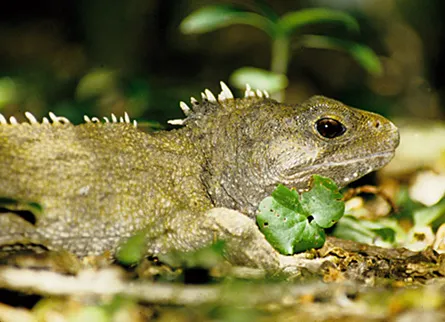Climate Threatens Living Fossil
The dating scene for unusual reptiles on certain South Pacific islands could get pretty stressful in coming decades. Guys already outnumber gals in some areas. With global warming, that tilted ratio threatens not only to become universal but also far more exaggerated. Or so concludes a new study.

It’s a facet of global warming that has largely escaped attention. But upon reflection, it’s clear that the reptiles studied should be far from the only ones that can develop perilously skewed sex ratios if our atmosphere’s growing fever continues its rise.
The new paper focuses on tuatara, somewhat-bizarre lizardlike creatures that exist as remnant populations and only on several uninhabited New Zealand islands. Most of these tiny landmasses amount to little more than sheer, rocky outcroppings no more than 5 hectares (~12 acres) in size. Their wildlife has developed in a fairly stable environment and relative isolation. Indeed, the tuatara are frequently characterized as living fossils for the fact that they’re the sole survivors of one of the four orders of reptiles and are little changed from ancient ancestors.
Among their many oddities, these critters have one of the longest reproductive cycles known, grow slowly, and may live four score years or more. Like many reptiles, their gender is determined by the temperature at which eggs incubate. And they incubate in earthen nests a long time — typically 11 to 14 months.
The warmer that nest, the more likely a hatchling will be a he, not a she. So, if the climate leads to substantial nest warming, there will likely come a time at which every tuatara born will be male. That time could be within this century, hints a paper published today in Proceedings of the Royal Society B, although Nicola J. Mitchell of the University of Western Australia and her colleagues leave fairly vague how soon that critical date might arrive.
Part of the reason: Theirs is a modeling paper. So the authors ran a range of scenarios through their computer program, graphing the projections it spit out. Gauging the most likely projection requires making a lot of assumptions — and hoping that the scientists or their computer model were sophisticated enough to account for the most likely factors that would affect gender. These include: how much the local climate will warm in the near future, whether nests will warm proportionately, whether tuatara will plant their eggs at lower depths to keep them cooler in the future, and whether moms will lay their clutch at the same open sites as the climate changes or instead begin to nest at shaded locales elsewhere on their island.
I ran the modeling assessments by Louis Guillette, a University of Florida herpetologist who has studied tuatara, including those on North Brother — the island whose population was modeled in the new paper.
Overall, he finds the conclusions spot on.
He does have a few quibbles about interpretations that gloss over factors that he worries may prove important. Such as genetic variability.
Among Louisiana gators, he notes, if you incubate their eggs at 33 °C, all hatchlings will emerge male. “We, in Florida, have to go to 33.5° to see the same pattern,” Guillette reports. Warm their nests just a bit more, to 34° or 35°, and “you’ll start to get major mortality” — and some female hatchlings again (just one of the quirks of their biology). If tuatara exhibit similar variability in temperature-skewed gender ratios between islands, or even within populations on an island, some might survive a warming world.
Guillette also notes that eggs are not the only temperature-sensitive members of a population. “Tuatara have one of the longest reproductive cycles: It’s almost four years,” he notes, with a female “taking almost three years to yolk up her eggs.” Afterwards, she’ll release them into a nest. Because her body judges when to breed based on temperature and other environmental cues, mom’s egg-production period might become seriously perturbed by a warming world, he says.
Another problem in assessing some reptiles’ climate vulnerability: lifespan. Tuatara and crocodilians (including Guillette’s beloved Florida gators) can live a half-century or more. In some long-lived critters, even 10 or 20 years of poor or gender-skewed reproduction may be compensated for in one or two good years later on. Not so for a frog species whose lifespan may be only a few years. There, 10 years of poor reproduction might result in its total extinction.
And tuatara? “They probably take 15 to 20 years to reach sexual maturity and don’t reach full size until they’re about 35 to 40,” Guillette reports. They not only appear capable of reproducing for a span of four to five decades, he says, “but probably live more than 100 years.”
Which points to another concern: In such slow-maturing, long-breeding species, impacts of perturbed gender ratios in the young may be masked for decades —by which time it may be too late to do anything about it.







